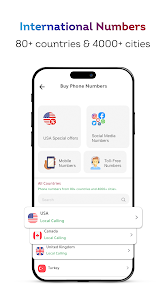Virtual sim number In an era dominated by technological advancements, the way we connect and communicate has undergone a revolutionary transformation. One such innovation that has gained significant attention is the concept of virtual SIM numbers. These digital alternatives to traditional SIM cards have opened new avenues for seamless connectivity, offering flexibility, security, and convenience to users around the world.

Understanding Virtual SIM Numbers:
A virtual SIM (Subscriber Identity Module) number is a digital representation of a traditional SIM card, providing users with the ability to make calls, send texts, and access data services without the need for a physical card or device. This technology leverages the power of the internet to create a virtual presence on a network, enabling users to enjoy the benefits of a mobile connection without the constraints of a physical SIM card.
Flexibility and Global Connectivity:
One of the key advantages of virtual SIM numbers is the flexibility they offer in terms of connectivity. Users can easily switch between multiple virtual SIMs on a single device, eliminating the need to carry multiple phones or swap physical SIM cards. This flexibility is particularly beneficial for individuals who frequently travel or need to manage multiple phone numbers for business or personal purposes.
Moreover, virtual SIMs transcend geographical boundaries, providing global connectivity without the hassle of roaming charges or the need to purchase local SIM cards. This is a game-changer for frequent travelers and international business professionals, allowing them to stay connected seamlessly regardless of their location.
Enhanced Privacy and Security:
Privacy concerns have become a significant issue in the digital age, and virtual SIM numbers address this by offering enhanced privacy and security features. With traditional SIM cards, the risk of physical loss or theft is always present. Virtual SIMs, on the other hand, are not tied to a physical device, reducing the chances of unauthorized access or misuse.
Additionally, virtual SIMs often come with advanced encryption protocols, ensuring secure communication and protecting user data from potential threats. This added layer of security is especially crucial in an era where cyber threats and identity theft are on the rise.
Cost-Efficiency and Sustainability:
Virtual SIM numbers contribute to cost efficiency in several ways. Firstly, users can avoid the costs associated with purchasing physical SIM cards, which is especially relevant in regions where acquiring a SIM card might involve administrative hurdles. Secondly, the ability to switch between virtual SIMs eliminates the need for multiple devices or dual SIM phones, saving users money on additional hardware.
From an environmental perspective, the adoption of virtual SIM numbers aligns with the growing emphasis on sustainability. The reduction of physical SIM cards translates to less plastic waste, contributing to a greener and more eco-friendly approach to connectivity.
Challenges and Considerations:
While virtual SIM numbers offer a range of benefits, it is essential to acknowledge the challenges and considerations associated with this technology. One primary concern is the dependence on internet connectivity. Virtual SIMs rely on a stable internet connection for their functionality, and in areas with poor network coverage, users may experience disruptions in service.
Furthermore, regulatory and legal frameworks vary across countries, and the use of virtual SIM numbers may be subject to restrictions or limitations. Users should be aware of the legal implications and compliance requirements associated with virtual SIM usage in their respective regions.
Conclusion:
The emergence of virtual SIM numbers represents a significant evolution in the realm of connectivity. With the promise of flexibility, enhanced privacy, and cost efficiency, these digital alternatives have the potential to reshape the way we approach mobile communication. As technology continues to advance, virtual SIM numbers are likely to play an increasingly prominent role in connecting individuals and businesses across the globe, providing a glimpse into the future of seamless, secure, and sustainable connectivity.


